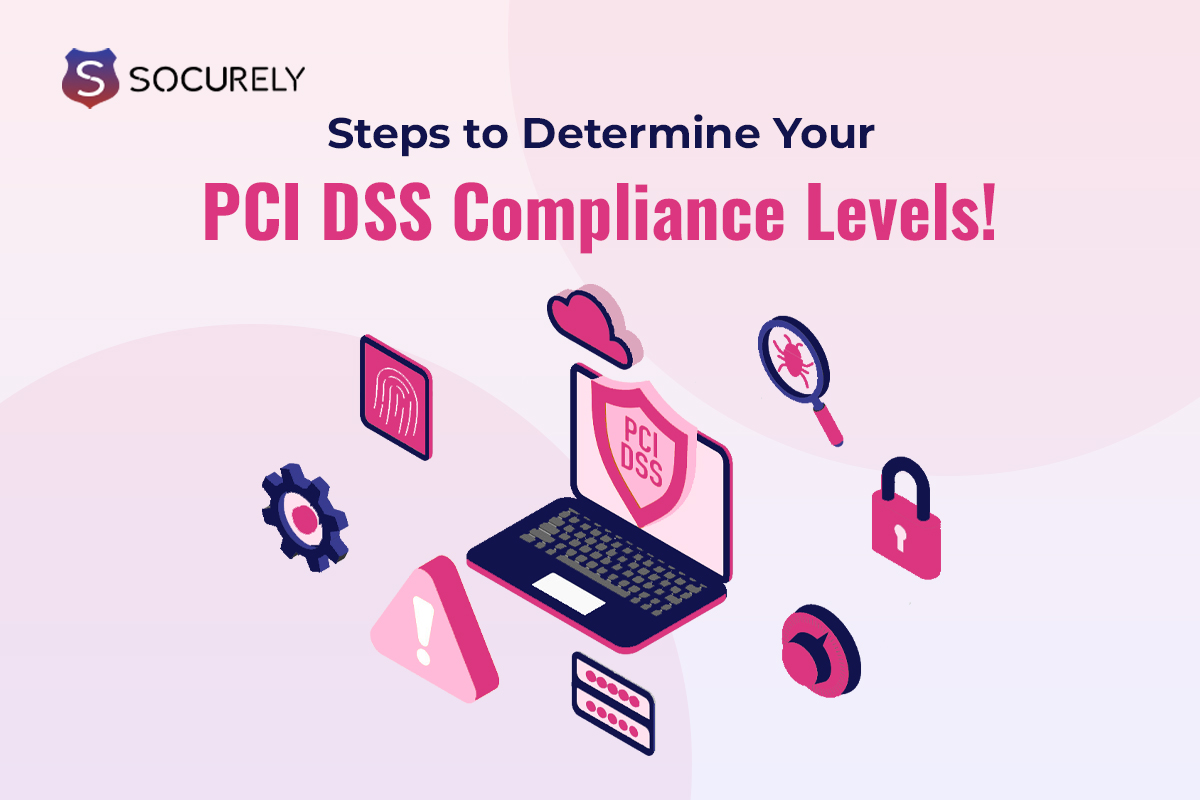PCI DSS compliance is mandatory for businesses, regardless of the volume of card transactions organizations conduct annually. It can be something like 10 million or more than 10 million. No matter whether you are a small business or a large business, the PCI DSS Framework can only protect your business transactions.
In the modern world, there is a greater chance of data breaches and security mishaps with more card transactions. The Payment Card Industry Data Security Standard (PCI DSS) divides companies into PCI compliance tiers to secure your business from this.
An essential first step in achieving PCI compliance is determining the compliance level of your company. Your PCI DSS level will specify what you must report and act as a guide for compliance. To help you determine, we’ve broken down the requirements below assisting you in identifying how PCI-compliant you are.
Understanding PCI DSS Framework
The PCI DSS framework is a set of security standards that ensures all companies that accept, process, store, or transmit credit card information maintain a secure environment. It is established by the Payment Card Industry Security Standards Council (PCI SSC) and aims to protect cardholder data and reduce credit card fraud.
The main objectives of this framework are-
- Secure network systems are built and maintained,
- protecting cardholder data,
- maintaining a vulnerability management program,
- implementing strong access control measures,
- regularly monitoring and testing networks,
- maintaining an information security policy.
Each objective encompasses specific requirements that organizations must meet to achieve compliance. Understanding this framework is crucial for businesses to implement robust security measures, protect sensitive data, and gain the trust of their customers. By adhering to the PCI DSS framework, organizations can significantly mitigate the risk of data breaches and ensure their operations align with industry standards.
**Also read the vital Tools and Resources For PCI DSS Compliance.
PCI DSS Merchants VS. Service Providers
Before determining your business’s PCI DSS level, you should know what type is your business. Ask yourself- is it a merchant or service provider type of business?
Merchants are businesses that accept credit card payments for goods or services. They range from small e-commerce websites to large retail chains and even include organizations that may only process a few transactions a year.
On behalf of merchants or other service providers, service providers process, store, or transmit cardholder data. They play a pivotal role in the payment ecosystem by facilitating transactions and ensuring data security.
**Also acknowledge the myths of PCI DSS Compliance!
Merchants and service providers, both categories need PCI DSS Compliance and play integral roles in the payment card industry but have different responsibilities and compliance obligations.
- Data Handling: Merchants typically handle cardholder data directly through transactions. Service providers manage data on behalf of others, often focusing more on infrastructure and systems that process and store this data.
- Compliance Reporting: Merchants primarily need to ensure their transactional processes are secure and comply with PCI DSS standards. Service providers must also demonstrate that their systems and networks are secure and capable of handling cardholder data in compliance with PCI DSS requirements.
- Audit Requirements: Level 1 merchants and service providers both need an annual ROC conducted by a QSA or an internal auditor. Lower levels typically require a self-assessment but must still meet rigorous security standards.
PCI DSS Merchant Levels
Merchants usually have 4 Types of PCI DSS Compliance Levels-
- PCI Level 1: Companies handling more than 6 million credit card transactions annually
- PCI Level 2: Companies handling one million to six million credit card transactions annually
- PCI Level 3: Companies handling 20,000–1,000,000 credit card transactions annually
- PCI Level 4: Organizations handling fewer than 20,000 credit card transactions annually
Different reporting requirements may apply to each PCI compliance level; for example, Level 4 may need self-attestation, whereas Level 1 may require a third-party PCI DSS audit.
PCI DSS Level 1-
Criteria: Process over 6 million Visa or MasterCard transactions annually, or meet specific criteria set by card brands (such as being the target of a data breach).
Requirements: The organization must complete an Annual Report on Compliance (ROC) which must be approved by a Qualified Security Assessor (QSA) or an internal auditor. They also need to conduct quarterly network scans by an Approved Scanning Vendor (ASV) and submit an annual Attestation of Compliance (AOC).
The AoC is the vital document that is approved by the QSA. It certifies that the company has complied with the PCI DSS standard.
It’s also crucial to remember that buying banks or other asking parties have the authority to classify any merchant who experienced a data breach that exposed cardholder information as Level 1.
PCI DSS Level 2-
Criteria: Process 1 million to 6 million Visa or MasterCard transactions annually.
Requirements: The PCI Level 2 merchants don’t need to submit an annual compliance audit report led by the QSA. Rather, they must complete an annual Self-Assessment Questionnaire (SAQ), conduct quarterly network scans by an ASV, and submit an annual AOC. You would probably have to have an independent QSA company certify this SAQ at PCI Level 2.
A set of self-guided questions called an SAQ evaluates your PCI compliance. The SAQ you complete will depend on whether you are a merchant or a service provider, as well as the kind of merchant you are. Normally, there remain eight different sorts of SAQs. SAQ types differ in the number of questions. With 24 questions, SAQ A is the shortest, while SAQ D has 328 questions.
PCI DSS Level 3-
Criteria: Companies handling 20,000 to 1 million e-commerce transactions annually.
Requirements: Merchants in this compliance level, must complete an annual SAQ, conduct quarterly network scans by an ASV, and submit an annual AOC.
PCI DSS Level 4-
Criteria: Organisations handling fewer than 20,000 e-commerce transactions annually and up to 1 million total transactions.
Requirements: Must complete an annual SAQ, conduct quarterly network scans by an ASV, and submit an annual AOC.
PCI DSS Service Provider Levels
Service providers are also categorized into levels based on the volume of transactions they handle. Like merchants, they must meet specific compliance requirements.
PCI DSS Level 1
Criteria: Service providers process more than 300,000 transactions annually.
Requirements: Must complete an annual ROC performed by a QSA or an internal auditor if signed by an officer of the company. They also need to conduct quarterly network scans by an ASV and submit an annual AOC.
PCI DSS Level 2
Criteria: Service providers process fewer than 300,000 transactions annually.
Requirements: Must complete an annual SAQ, conduct quarterly network scans by an ASV, and submit an annual AOC.
Determine The PCI Compliance Levels For Your Business
Determining your PCI compliance level involves assessing the volume of card transactions your business processes annually. Here’s a step-by-step guide:
- Calculate Transaction Volume: Tally the number of credit card transactions processed over the past year or the last 52 weeks.
- Identify Business Type: Determine whether your business is a merchant or a service provider.
- Match Criteria: Compare your transaction volume with the criteria for each PCI DSS level.
- Review Requirements: Understand the specific requirements for your identified level, including necessary documentation, security assessments, and compliance reports.
Besides the steps, you can take expert PCI DSS Compliance help! Contact us today!
Get Started With Socurely PCI DSS Framework
As the leading provider of PCI DSS compliance solutions, Socurely offers a comprehensive framework to help your business achieve and maintain PCI DSS compliance effortlessly. Our proven approach ensures that your organization meets all requirements while safeguarding cardholder data. Socurely can help you navigate the complexities of PCI DSS compliance by providing:
Risk Assessment: Identify and evaluate potential security risks.
Policy Development: Create robust information security policies tailored to your business.
Employee Training: Ensure your team understands and implements security practices.
Internal Audits: Conduct regular audits to assess compliance and identify improvements.
Continuous Improvement: Offer ongoing support to enhance your security measures.
Conclusion
Determining your PCI DSS compliance level is a critical step in protecting your business and customer data. By understanding the requirements and following a structured approach, you can ensure compliance and enhance your security posture. Partnering with Socurely means you can focus on running your business while we take care of your PCI DSS compliance needs. Our expert team is dedicated to helping you achieve and sustain compliance, giving you peace of mind and protecting your customers’ data. Get started with Socurely’s PCI DSS framework today and ensure your business meets the highest standards of data security.
FAQ
Why Determining PCI DSS Levels is Important?
Determining your PCI DSS compliance level is essential because it defines the specific security requirements your business must meet. This helps ensure you implement appropriate measures to protect cardholder data, reducing the risk of data breaches and enhancing customer trust.
What Are the 6 Compliance Groups for PCI DSS?
The six compliance groups for PCI DSS are:
- Build and Maintain a Secure Network and Systems
- Protect Cardholder Data
- Maintain a Vulnerability Management Program
- Implement Strong Access Control Measures
- Regularly Monitor and Test Networks
- Maintain an Information Security Policy
What Are the PCI DSS Levels?
PCI DSS levels refer to the categorization of merchants and service providers based on the volume of card transactions processed annually. They help determine the specific compliance requirements for each business.
How to Become Level 3 PCI DSS?
To become Level 3 PCI DSS compliant, a business must process between 20,000 to 1 million e-commerce transactions annually. Compliance requires completing an annual SAQ, conducting quarterly network scans by an ASV, and submitting an annual AOC.
What Does PCI Level 1 Mean?
PCI Level 1 is the highest compliance level for merchants and service providers. It applies to those processing over 6 million transactions per year for merchants or over 300,000 transactions annually for service providers. Compliance requires an annual ROC by a QSA or internal auditor, quarterly network scans by an ASV, and an annual AOC.







